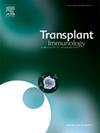Donor lymphocyte infusion-based therapy for relapsed adult T-cell leukemia/lymphoma after HLA-haploidentical hematopoietic stem cell transplantation
IF 1.4
4区 医学
Q4 IMMUNOLOGY
引用次数: 0
Abstract
Donor lymphocyte infusion (DLI) combined with chemotherapy is an effective therapy for relapsed adult T-cell leukemia/lymphoma (ATL) after allogeneic hematopoietic stem cell transplantation from a human leukocyte antigen (HLA)-matched related donor or matched unrelated donor. The 1-year incidence of ATL relapse is 28 % after HLA-haploidentical hematopoietic stem cell transplantation (haplo-HSCT) with post-transplant cyclophosphamide. However, the efficacy of DLI for relapsed ATL after haplo-HSCT remains unclear. Here, we present the case of a 61-year-old woman diagnosed with ATL who underwent haplo-HSCT from an HLA-haploidentical relative donor. On day +164 after transplantation, the patient experienced ATL relapse. Tacrolimus was tapered and discontinued on day +216; however, ATL progressed. Since the patient did not develop graft-versus-host disease (GVHD) after the discontinuation of tacrolimus, DLI following chemotherapy was performed for relapsed ATL. The patient achieved complete remission without severe GVHD after the 6th DLI treatment. This remission has been sustained for over 15 months with 13 DLI treatments. These results suggest the potential of DLI combined with chemotherapy as a treatment option for patients with relapsed ATL after haplo-HSCT.
基于供体淋巴细胞输注的治疗hla -单倍体造血干细胞移植后复发的成人t细胞白血病/淋巴瘤
供体淋巴细胞输注(DLI)联合化疗是治疗来自人类白细胞抗原(HLA)匹配的相关供体或匹配的非相关供体的异基因造血干细胞移植后复发的成人t细胞白血病/淋巴瘤(ATL)的有效治疗方法。移植后使用环磷酰胺的hla -单倍体造血干细胞移植(haploi - hsct)后1年ATL复发率为28%。然而,DLI治疗单倍hsct后复发ATL的疗效尚不清楚。在这里,我们提出了一个61岁的女性诊断为ATL的病例,她接受了来自hla -单倍相同的亲属供体的单倍造血干细胞移植。移植后第164天,患者ATL复发。他克莫司逐渐减少并在第216天停用;然而,ATL进展。由于患者在停用他克莫司后未发生移植物抗宿主病(GVHD),因此对复发性ATL进行化疗后的DLI。患者在第6次DLI治疗后完全缓解,无严重GVHD。通过13次DLI治疗,这种缓解持续了超过15个月。这些结果表明,DLI联合化疗可能是单倍hsct后复发ATL患者的治疗选择。
本文章由计算机程序翻译,如有差异,请以英文原文为准。
求助全文
约1分钟内获得全文
求助全文
来源期刊

Transplant immunology
医学-免疫学
CiteScore
2.10
自引率
13.30%
发文量
198
审稿时长
48 days
期刊介绍:
Transplant Immunology will publish up-to-date information on all aspects of the broad field it encompasses. The journal will be directed at (basic) scientists, tissue typers, transplant physicians and surgeons, and research and data on all immunological aspects of organ-, tissue- and (haematopoietic) stem cell transplantation are of potential interest to the readers of Transplant Immunology. Original papers, Review articles and Hypotheses will be considered for publication and submitted manuscripts will be rapidly peer-reviewed and published. They will be judged on the basis of scientific merit, originality, timeliness and quality.
 求助内容:
求助内容: 应助结果提醒方式:
应助结果提醒方式:


